Lama Tsongkhapa: A Short, Powerful Practice Helps Bring Compassion, Wisdom, Good Fortune, and Healing
“In my opinion, having the opportunity to practice the guru yoga of the great holy being Lama Tsongkhapa, is more fortunate than having the chance to receive and practice other Dharma teachings,” wrote Lama Zopa Rinpoche, in the book Guru Yoga.
“After I pass away and my pure doctrine is absent,
You will appear as an ordinary being,
Performing the deeds of a Buddha
And establishing the Joyful Land, the great Protector,
In the Land of the Snows.”-Buddha Shakyamuni in the Root Tantra of Manjushri
Many great teachers rely on Lama Tsongkhapa
Many famous gurus, lamas and teachers — including the Dalai Lama, (two videos from His Holiness below), Lama Zopa Rinpoche, H.E. Zasep Tulku Rinpoche, and most Tibetan Gelugpa teachers — teach this very powerful, yet accessible practice. The practice does not require initiation or empowerment—although the guidance of a teacher and initiation are beneficial.
Kyabje Lama Zopa Rinpoche advised:
“If one keeps even a drop of the nectar of the name of this holy being Lama Tsongkhapa in a devotional heart, it plants the seed of liberation and one receives the fortune to practice and enjoy happiness from this life up to enlightenment.”
The Migtsema mantra of Lama Tsongkahpa is a complete practice. Chant along with the wonderful voice of Yoko Dharma:
The Buddha of Our Times
Lama Tsongkhapa is a “Buddha of our times” in the Gelug Vajrayana tradition. As an enlightened being, Buddha Tsongkhapa has the same realizations as all of the Conquerors (Buddhas). His practice is very powerful, in part, because he was an emanation of Avalokitesvara (compassion), Manjushri (wisdom), and Vajrapani (power). Famously, Lama Tsongkhapa wrote the three volume Lam Rim Chenmo text: The Great Treatise on the Stages of the Path to Enlightenment (see below), books on Lamrim that numerous serious practitioners read, reread and refer to throughout their lives.
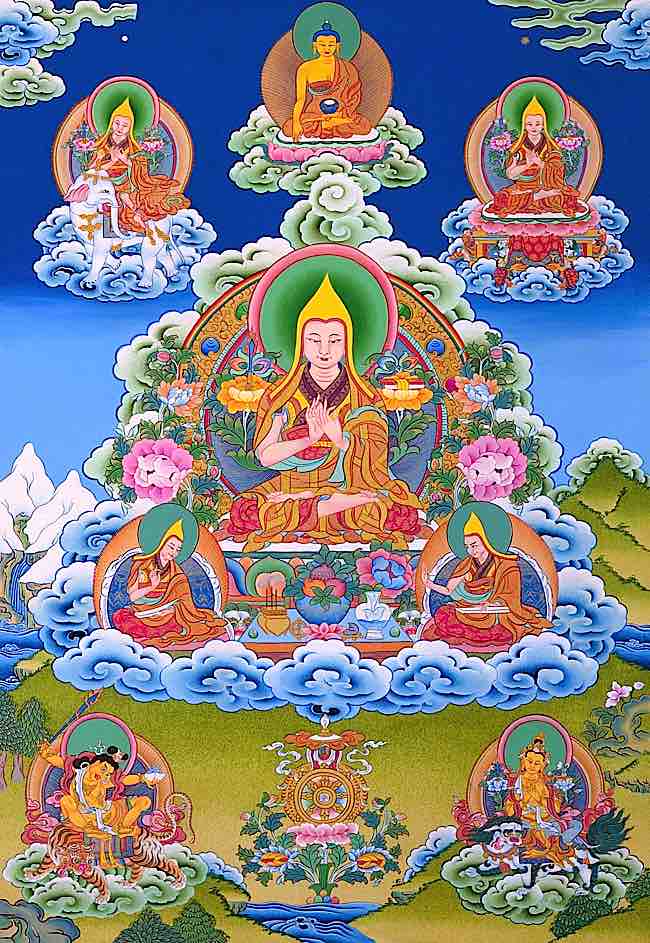
He is visualized as a wise and kind guru, smiling and beautiful, with a tall yellow pandit’s hat, seated on a lotus throne, with all the marks and signs of a Buddha. His kind, smiling visage makes him approachable to many new to His practice, while his authority as a great Sage makes him reliable and beneficial.
His Holiness the Dalai Lama teachings on Lama Tsongkhapa, Commentary on Lam Rim Chenmo:
Tsongkhapa, the Second Great Sage
Tsongkhapa (Je Tsong-kha-pa Blo-bzang grags-pa) (1357-1419) is considered, by millions, to be a great sage. Shakyamuni, the historical Buddha, is the great Sage of our times, the Enlightened Buddha. Padmasambhava (Guru Rinpoche), another enlightened sage, foretold Tsongkhapa’s coming.
Tsongkhapa famously wrote numerous authoritative texts, and notably the Lamrin Chenmo. His teachings rejuvenated Buddhism, and fused Sutra practices with Tantra. Tsongkhapa’s teachings instilled such belief and practice in Tibetan Buddhists that it had a profound impact on the history of Asia. Practices Tsongkhapa taught found their way into China, Japan, Korea, India and ultimately around the world.
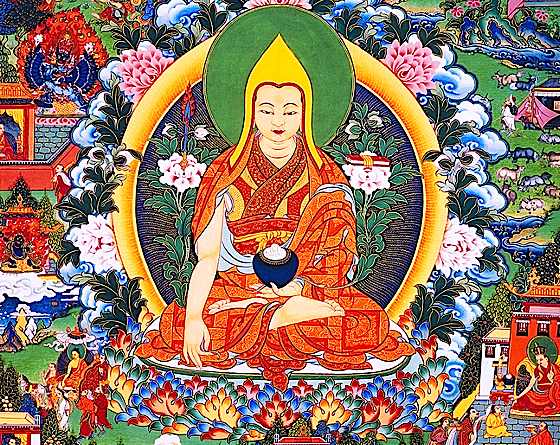
“Both Buddha Shakyamuni and Guru Rinpoche prophesied Tsongkhapa’s birth and attainments,” wrote Alexander Berzin, August 2003, partly based on a discourse by Geshe Ngawang Dhargyey, Dharamsala, India. “Buddha prophesied Manjushri would be born as a boy in Tibet, would found Ganden monastery, and would present a crown to [Buddha’s] statue… Guru Rinpoche also prophesied a monk named Lozang-dragpa would be born near China, would be regarded as an emanation of a great bodhisattva…”
In the Manjushri Root Text Buddha says, “After I have passed away, you will in the form of a child perform the actions of buddha.”
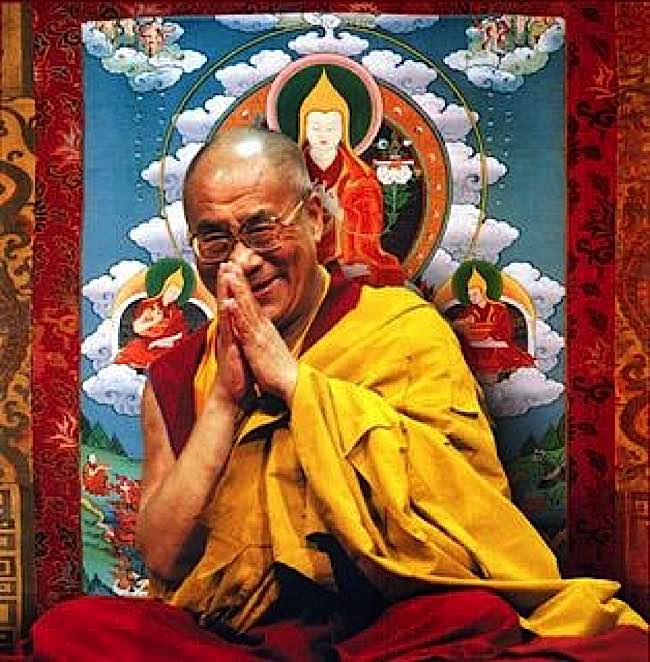
Tsongkhapa Practice: Short, Complete and Powerful
Daily Lama Tsongkhapa’s Guru Yoga makes it easier for us to develop compassion, and let go of anger. It is a short practice, ideal for busy people with little time to meditate.
Many Gelugpa teachers advocate Lamrim and foundation practices, including Lama Tsongkhapa and Vajrasattva practice. For example, the students of teacher Venerable Zasep Tulku Rinpoche, are taught in the “Guidelines for Students” to study sutra, tantra, Mamhamudra, Lam Rim Chen Mo, and deity yoga: “This is the order… Lama Tsongkhapa including Manjushri, Chenrezig, Vajrapani” followed by other Kirya Tantra deity practices.
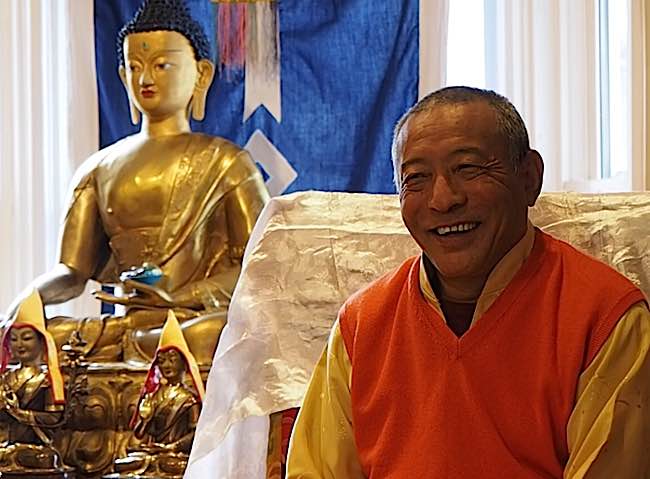
Tsongkhapa Mantra and Migstema
The mantra of Lama Tsongkhapa, which can be spoken by anyone, is:
OM AH GURU VAJRADHARA SUMATI KIRTI SIDDHI HUM
The Migstema Tsongkhapa mantra chanted by Chanted by Lama Ngawang Thogmey. Recorded in san Antonio, Texas.
The Migstema mantra can also be spoken and visualized by anyone for great benefits:
MIG MEY TZE WAY TER CHEN CHENREZIG
DRI MEY KHYEN PI WANG PO JAMPAL YANG
DU PUNG MA LU JOM DZEY SANG WEY DAG
GANG CHENG KE PEY TSUG GYEN TSONGKHAPA
LO SANG TRAG PEY SHAB LA SOL WA DEB
This can also be spoken in English, although it tends to be easier to memorize, chant and empower in the Tibetan. The English reads as:
Objectless compassion, Cherezig
Lord of stainless wisdom, Manjushri,
Conquering mara’s hordes, Vajrapani,
Crown jewel of the Sages of the Land of Snows, Tsongkhapa,
Losang Drakpa, at your feet, I pray.
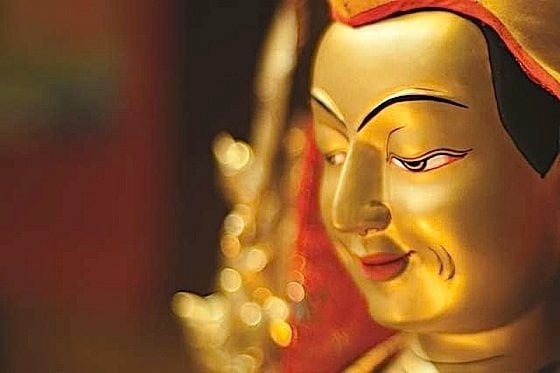
Some teachers say that the Migstema mantra is so very powerful because it combines the great mantras of Avalokitesvara (Chenrezig), Manjushri and Vajrapani:
Objectless compassion, Cherezig OM MANI PADME HUM
Lord of stainless wisdom, Manjushri OM AH RA BA TSA NA DHI
Conquering mara’s hordes, Vajrapani OM VAJRAPANI HUM
Crown jewel of the Sages of the Land of Snows, Tsongkhapa,
Losang Drakpa, at your feet, I pray.
A Simple Practice Containing All 84,000 Teachings of Lord Buddha
The short Guru Yoga of Lama Tsongkhapa, on one level, contains all the 84,000 teachings of Lord Buddha. As the practice is short, it is easy to memorize, and quick to practice — ten minutes from beginning to end if you don’t pause to meditate or to chant extra mantras.
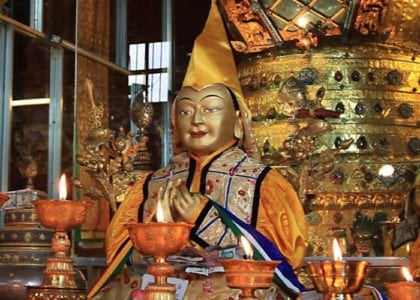
In the very precious Tibetan Buddhist tradition, practices always incorporate all three of the body, speech and mind. For example:
- For body, we might fold our hands in prayer, bow, or make a symbolic mudra (hand gesture) for offerings.
- For speech, we say the words of praise, the vows of Bodhichitta, and the mantras which help focus our minds
- For mind, especially in Tibetan tradition, we visualize or imagine the Buddha in our minds, and also try to keep that visualization and the practice in context with the concept of wisdom — in this case, our own understanding of emptiness, dependent arising and so on.
As always, with any traditional Mahayana practice, there are common elements with all practices, including:;
- Refuge: we always take refuge in the three jewels: Buddha Dharma, and Sangha
- Bodhichitta vow: the most precious promise to benefit all sentient beings
- The Four Immeasurable Attitudes: aspirations for the benefit of al all beings
- Visualization: imagining or picturing the “merit field” which means picturing the Enlightened Buddha (in this case Lama Tsongkhapa) and his disciples or attendants.
- Seven Limbed Prayer: prostrations, offerings, declarations, rejoicing, requesting teachings, requesting Lama Tsongkahapa remain with us always, and a dedication.
- Offering: in this case a short mandala offering
- Mantra: spoken and visualized: often visualizing healing light from Lama Tsonkhapa going out to all sentient beings and easing their suffering.
- Final Dedication: all Tibetan practices always dedicated the merit of the virtue of the practice to the cause for Enlightenment for the benefit of all sentient beings.
Guru Yoga Practice of Lama Je Tsongkhapa
This version, excerpted from Gaden Choling/ Gaden for the West practice assembled under the guidance of His Eminence Zasep Tulku Rinpoche. [1]
Refuge and Bodhichitta

Say three times:
I take refuge in the Buddha, the Dharma, and the Sangha,
Until I attain enlightenment.
By the merit accumulated from practicing generosity and the other perfections,
May I attain Enlightenment in order to benefit all sentient beings.
Cultivating Four Immeasurable Attitudes
Say three times:
May all beings have happiness and its causes,
May all beings be freed from suffering and its causes;
May all beings constantly dwell in joy transcending sorrow;
May all beings dwell in equal love for those both close and distant.
Visualization and Practice
Speak aloud and visualize:
From the heart of the Protector of the hundreds of deities of the the Joyful Land,
To the peak of a cloud which is like a cluster of fresh, white curd,
All-knowing Losang Dragpa, King of the Dharma,
Please come to this place together with your two chief disciples.
In the space before me on a lion throne, lotus, and moon,
The Venerable Gurus smile with delight.
Supreme Field of Merit for my mind of faith,
Please remain for a hundred aeons to spread the teaching.
Seven-Limbed Prayer
Now that you’ve invited and visualized, perform the seven-limbed prayer with all your heart:
Prostrations
Your minds of wisdom realize the full extent of objects of knowledge,
Your eloquent speech is the ear-ornament of the fortunate,
Your beautiful bodies are ablaze with the glory of renown.
I prostrate to you, whom to see, to hear, and to remember is so meaningful.
Offerings
Pleasing water offerings, various flowers,
Sweet-smelling incense, lights, scented water and so forth,
A vast cloud of offerings both set out and imagined,
I offer to you, Supreme Field of Merit.
Declarations
Whatever non-virtues of body, speech and mind
I have accumulated since time without beginning,
Especially transgressions of my three levels of vows,
With great remorse I declare each one from the depths of my heart.
Rejoicing
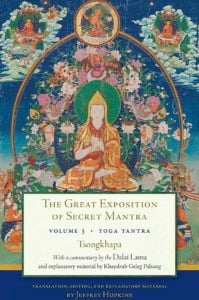
In this degenerate age you strove for much learning and accomplishment.
Abandoning the eight worldly concerns, you made your leisure and endowment meaningful.
Protector, from the very depths of my heart,
I rejoice in the great wave of your deeds.
Request for Dharma Teachings
From the billowing clouds of wisdom and compassion
In the space of your Enlightened minds, venerable and holy Gurus,
Please send down a rain of vast and profound Dharma
Appropriate to the disciples of this world.
Request to Remain
May your Vajra Body, created from the purity of clear light,
Free of the rising and setting of cyclic existence,
But visible to the ordinary viewer only in its unsubtle, physical form,
Stay on unchanging, without waning, until samsara ends.
Dedication
Through the virtues I have accumulated here,
May the teachings and all living beings receive every benefit. Especially may the essence of the teaching
Of Lama Je Tsong Khapa shine forever.
Short Mandala Offering
Mandala offerings from the heart are important. Visualize offering these offering objects as you say:
This mandala is built on a base resplendent with flowers, saffron water and incense,
Adorned with Mount Meru, the four lands, the sun and full moon.
By offering this pure mandala to you assembly of Buddhas here before me,
May all living beings experience pure happiness and be reborn in pure lands.
The objects of desire, aversion and ignorance,
Friend, enemy, and stranger, my body and all possessions,
These I offer without clinging for your enjoyment, Please bless me and all living beings to be released
From the three poisonous minds
OM IDAM GURU RATNA MANDALA KAMNIR YATAYAMI
I send forth this jewelled mandala to you, precious gurus.
Mantra and Migstema
Visualize as instructed by your teacher, or for a basic visualization you can visualize healing light going out to all sentient beings (including yourself) from the heart of Lama Tsongkhapa:
MIG.ME TZE.WAI TER.CHEN CHEN.RE.ZIG
DRI.ME KYEN.PAI WANG.PO JAM.PEL.YANG
DÜ.PUNG MA.LÜ JOM.DZE SANG.WAI DAG
GANG.CHEN KAY.PAI TZUG.GYAN TSONG.KHAPA
LO.ZANG DRAG.PAI ZHAB.LA SOL.WA DEB
You are Avalokitesvara, great treasure of unimaginable compassion,
And Manjushri, master of flawless wisdom,
And Vajrapani, Lord of the Secret and destroyer of hordes of maras without exception.
Tsong Khapa, crown jewel of the sages of the land of snows,
Lozang Dragpa, I make requests at your lotus feet.
MANTRA 7, 21, 108 or as many recitations as you can
OM AH GURU VAJRADHARA SUMATI KIRTI SIDDHI HUM
Requests
Glorious, precious root Guru,
Please come to the lotus and moon seat at my crown,
And in your great kindness, please remain with me.
Please bestow upon me the blessings of your body, speech and mind.
Glorious, precious root Guru,
Please descend to the lotus and moon seat in my heart,
And in your great kindness, please remain with me.
Please grant me the common and supreme realizations.
Glorious, precious root Guru,
Please remain on the lotus and moon seat in my heart,
And in your great kindness, please remain with me.
Please remain until I achieve the essence of Enlightenment.
Dedication
By this virtue may I quickly
Attain the state of a Guru-Buddha (Enlightenment),
And then may I lead every being,
without exception, into that state.
May the most precious and supreme bodhicitta awakening mind
Which has not yet been generated now be generated.
And may the precious mind of bodhicitta which has been generated
Never decline, but always increase.
Tsongkhapa the Scholar: The Great Treatise on the Stages of the Path to Enlightenment
Tsongkhapa’s writings, particularly his The Great Treatise On The Stages Of The Path To Enlightenment, helped re-invigorate the practices of Vajrayana Buddhism, and has been read and studied by countless students. Now, translated into English, in three volumes, The Great Treatise On The Stages Of The Path To Enlightenment is accessible to English-speaking peoples for the first time.
Dalai Lama introduces extensive teachings in Tsongkhapa and Lamrim:
“Of the many works of the Tibetan master Tsongkhapa, none compare in terms of popularity and breadth of influence with his Great Treatise on the Stages of the Path to Enlightenment (Lamrim Chenmo), which has been treasured by practitioners and scholars alike for centuries,” wrote His Holiness the IVth Dalai Lama.

“What distinguishes it as one of the principal texts of Mahayana Buddhism is its scope and clarity. It expounds the entire path from the way one should rely on a spiritual teacher, which is the very root, right up to the attainment of Buddhahood, which is the final fruit. The various stages of the path are presented so clearly and systematically that they can be easily understood and are inspiring to put into practice.”
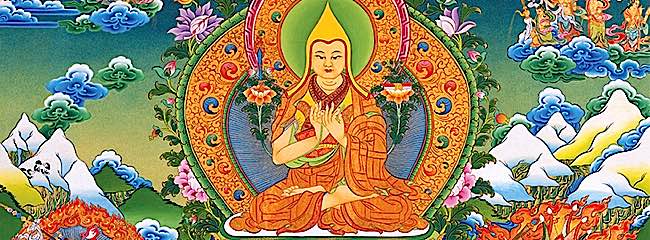
In Praise Of The Incomparable Tsongkhapa
By Gyalwa Mikyo Dorje, the Eighth Karmapa (1507 – 1554)
Once when Gyalwa Mikyo Dorje was traveling through the Charida Pass, thoughts of the incomparable Tsongkhapa welled up within him. Overcome by profound faith, he was moved to compose the above poem.
At a time when nearly all in this Northern Land
Were living in utter contradiction to Dharma,
Without illusion, O Tsongkhapa, you polished the teachings.
Hence I sing this praise to you of Ganden Mountain.
When the teachings of the Sakya, Kargu, Kadam
And Nyingma sects in Tibet were declining,
You, O Tsongkhapa, revived Buddha’s Doctrine,
Hence I sing this praise to you of Ganden Mountain.
Manjushri, the Bodhisattva of Wisdom, gave to you
Special instructions on the thought of Nagarjuna.
O Tsongkhapa, upholder of the Middle Way,
I sing this praise to you of Ganden Mountain.
“Mind and form are not empty of their own natures
But are empty of truly existent mind and form”,
You, O Tsongkhapa, are Tibet’s chief exponent of voidness,
Hence I sing this praise to you of Ganden Mountain.
In merely a few years you filled
The land from China to India
With peerless holders of the saffron robes.
Hence I sing this praise to you of Ganden Mountain.
Those who become your followers
And look to you and your teachings
Are never again disappointed or forsaken.
Hence I sing this praise to you of Ganden Mountain.
The trainees who walk in your footsteps
Breath the fresh air of the Great Way.
They would die for the good of the world.
Hence I sing this praise to you of Ganden Mountain.
Anyone who disparages your doctrine must face
The terrible wrath of the Dharma protectors.
O Tsongkhapa, who abides in truth’s power,
I sing this praise to you of Ganden Mountain.
In person and in dreams you come to those
Who but once recollect your image.
O Tsongkhapa, who watches with compassionate eyes.
I sing this praise to you of Ganden Mountain.
In order to civilize men and spirits you spread
Your teachings through Kham, Mongolia and Turkestan:
O Tsongkhapa, subduer of savages,
I sing this praise to you of Ganden Mountain.
For men coarse and far from the Way, you dispel
Mental clouds, evils and bad karma.
O Tsongkhapa, who bestows quick progress,
I sing this praise to you of Ganden Mountain.
Those who take heartfelt Refuge in you,
Even those with no hope for now or hereafter,
O Tsongkhapa, have their every wish fulfilled.
Hence I sing this praise to you of Ganden Mountain.
Having exposed false teachings transgressing
The excellent ways well shown by Buddha,
You firmly established your Bold Doctrine.
Hence I sing this praise to you of Ganden Mountain.
Manifesting sublime austerity and discipline,
The form and fragrance of your life was incomparable.
O Tsongkhapa, controlled one pleasing to the Buddhas,
I sing this praise to you of Ganden Mountain.
By the strength of the sons of your lineage
And by my having faithfully offered this praise,
May the enlightened activity of Buddha Shakyamuni
Pervade the earth for ages to come.
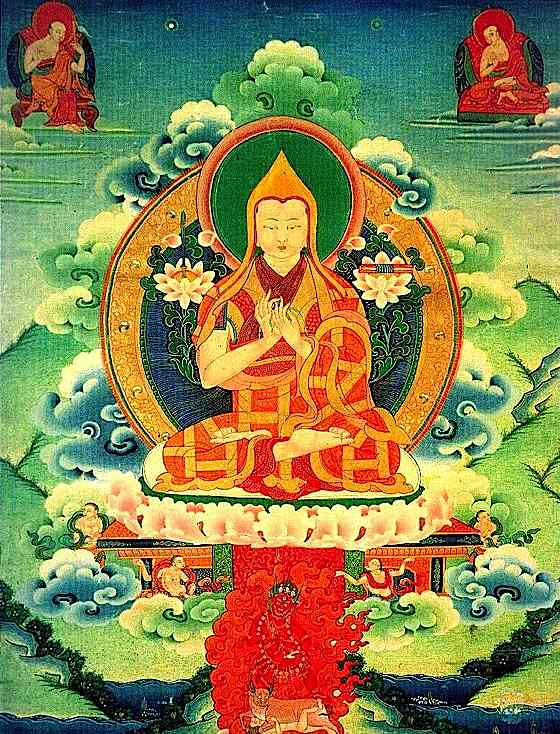
Lama Zopa Rinpoche’s Dedication:
From the merits collected by doing this work, transmitting Lama Tsongkhapa’s pure teaching — the heart of the 84,000 teachings of Buddha — into a western language, in a way as close as possible to the words and the meaning of the root text;May this be most beneficial for all sentient beings, bringing kind mother sentient beings — whose lives are lost, under the control of karma and delusion, totally enveloped in the darkness of ignorance — to the achievement of enlightenment as quickly as possible.
May anyone who merely sees this text, reads this text, teaches this text, hears about this text, or keeps this text thereby actualize indestructible guru devotion, seeing the Guru as Buddha, and train well in the three common principles of the path, actualize the two stages, and achieve the unified state of Vajradhara as soon as possible. May he or she especially generate loving kindness, the compassionate thought, and bodhicitta and immediately become a source of peace and happiness for all sentient beings, especially in this world, and may all war, famine, disease, sickness, epidemics, torture, poverty, and the dangers of fire, water, wind, and earthquakes immediately cease so that no one will experience any of these undesirable circumstances ever again.
May the pure teachings of Lama Tsongkhapa flourish continuously and spread in all directions.
3 thoughts on “Lama Tsongkhapa: A Short, Powerful Practice Helps Bring Compassion, Wisdom, Good Fortune, and Healing”
Leave a Comment
More articles by this author

Guru Rinpoche is ready to answer and grant wishes: “Repeat this prayer continuously” for the granting of wishes

VIDEO: Vajrapani Vajra Armor Mantra: Supreme Protection of Dorje Godrab Vajrakavaca from Padmasambhava
Search
Latest Features
Please support the "Spread the Dharma" mission as one of our heroic Dharma Supporting Members, or with a one-time donation.
Please Help Support the “Spread the Dharma” Mission!

Be a part of the noble mission as a supporting member or a patron, or a volunteer contributor of content.
The power of Dharma to help sentient beings, in part, lies in ensuring access to Buddha’s precious Dharma — the mission of Buddha Weekly. We can’t do it without you!
A non-profit association since 2007, Buddha Weekly published many feature articles, videos, and, podcasts. Please consider supporting the mission to preserve and “Spread the Dharma." Your support as either a patron or a supporting member helps defray the high costs of producing quality Dharma content. Thank you! Learn more here, or become one of our super karma heroes on Patreon.
Lee Kane
Author | Buddha Weekly
Lee Kane is the editor of Buddha Weekly, since 2007. His main focuses as a writer are mindfulness techniques, meditation, Dharma and Sutra commentaries, Buddhist practices, international perspectives and traditions, Vajrayana, Mahayana, Zen. He also covers various events.
Lee also contributes as a writer to various other online magazines and blogs.




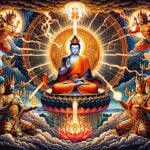

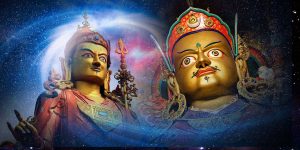

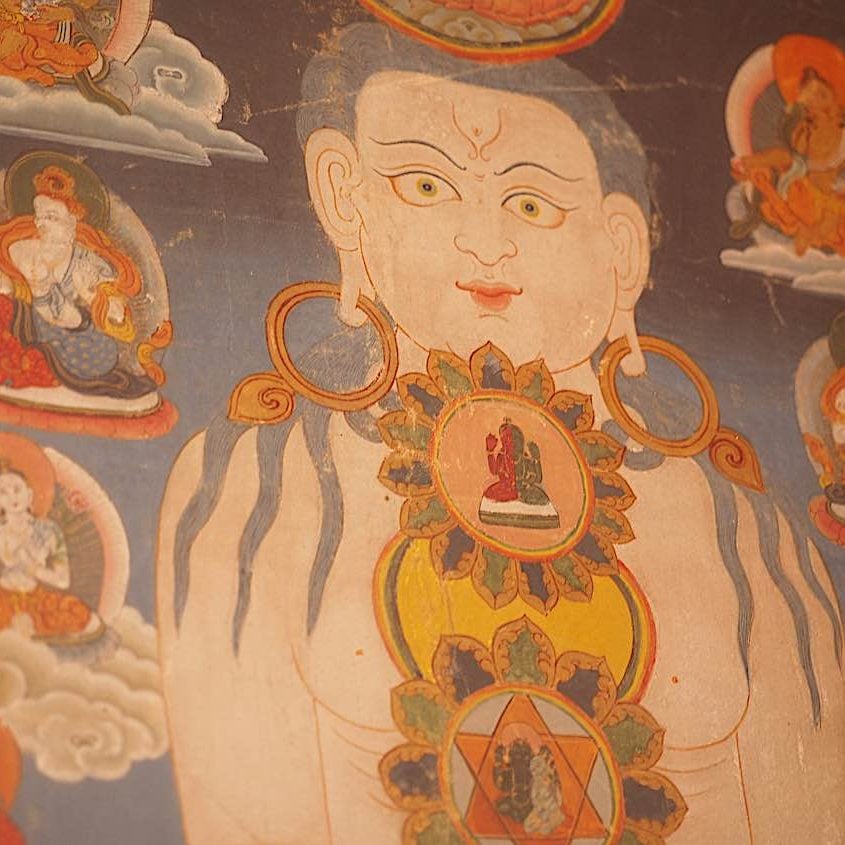

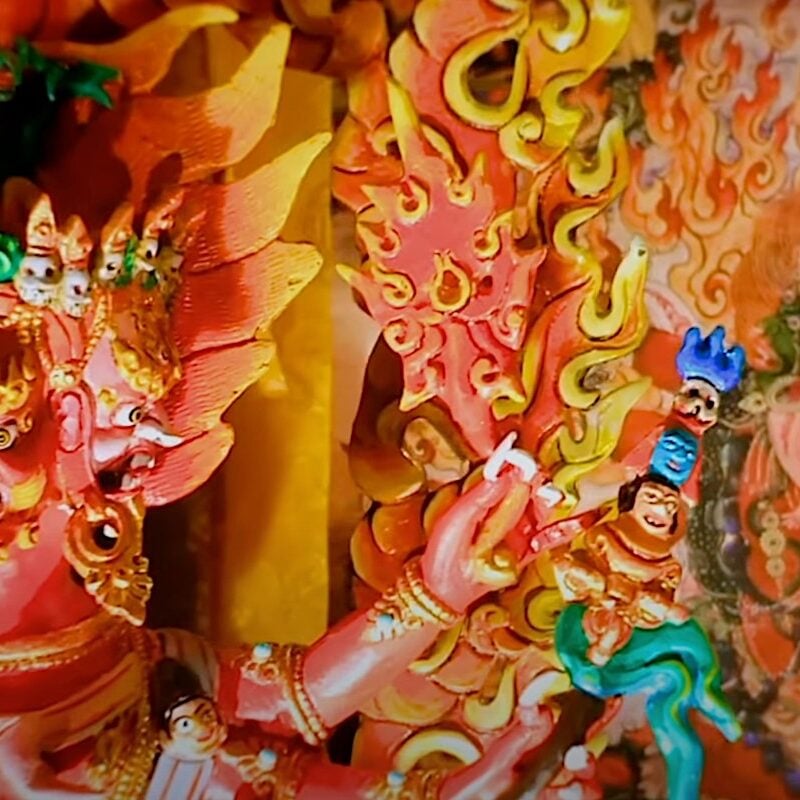




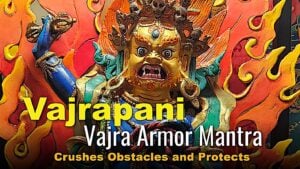
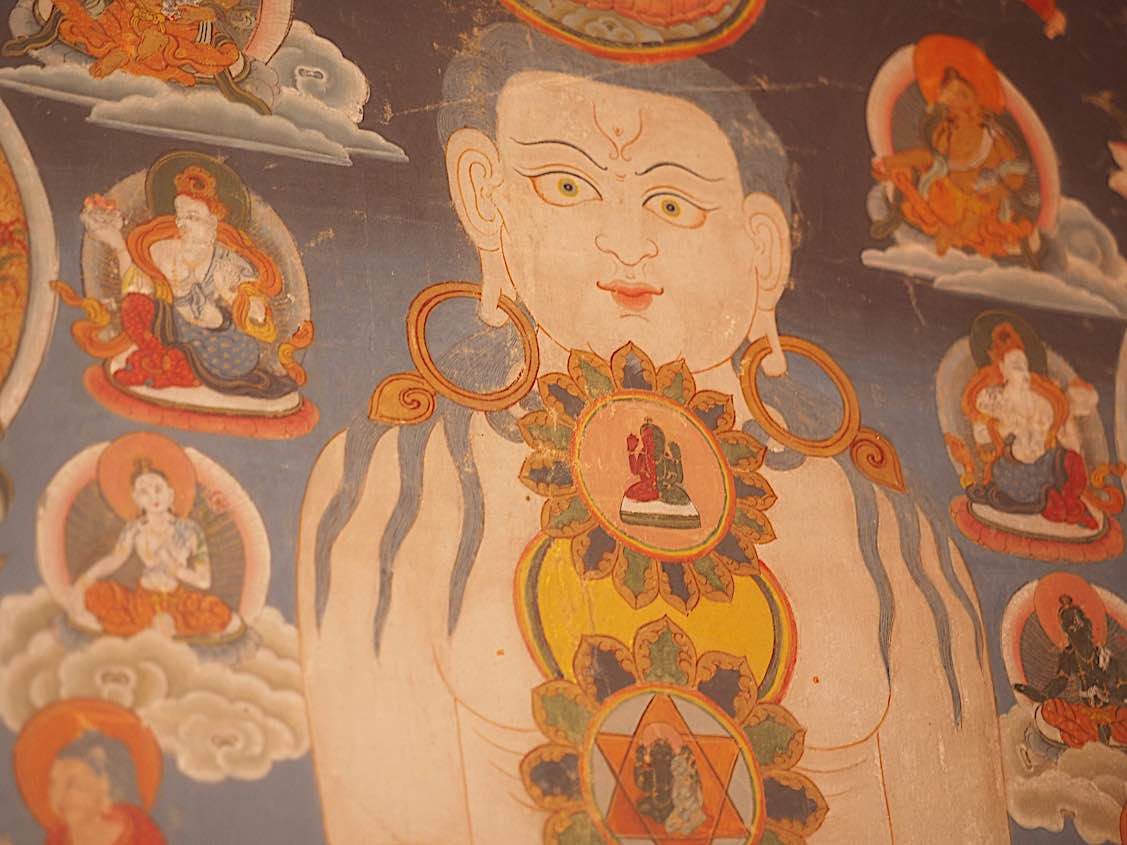
Great Treatise on the Stages of the Path to Enlightenment (Lamrim Chenmo) truly is the path to enlightenment.
Thanks for the recommendation, Lee. I will read the book in the near future.
The Migtsema mantra of Lama Tsongkhapa is one of the most beautiful mantras, in my opinion. It touches the deepest place of my heart. It is very mysterious, because I had no connection to Tsongkhapa in my life. The mantra gives me the feeling that he is my best and loyal friend. Truly, the Buddhas, the enlightened beings, are the best friends of all sentient beings. Seeing that truth clearly brings tears to my eyes
“If one keeps even a drop of the nectar of the name of this holy being Lama Tsongkhapa in a devotional heart, it plants the seed of liberation and one receives the fortune to practice and enjoy happiness from this life up to enlightenment.”
Beautiful! I am grateful forever 🙂